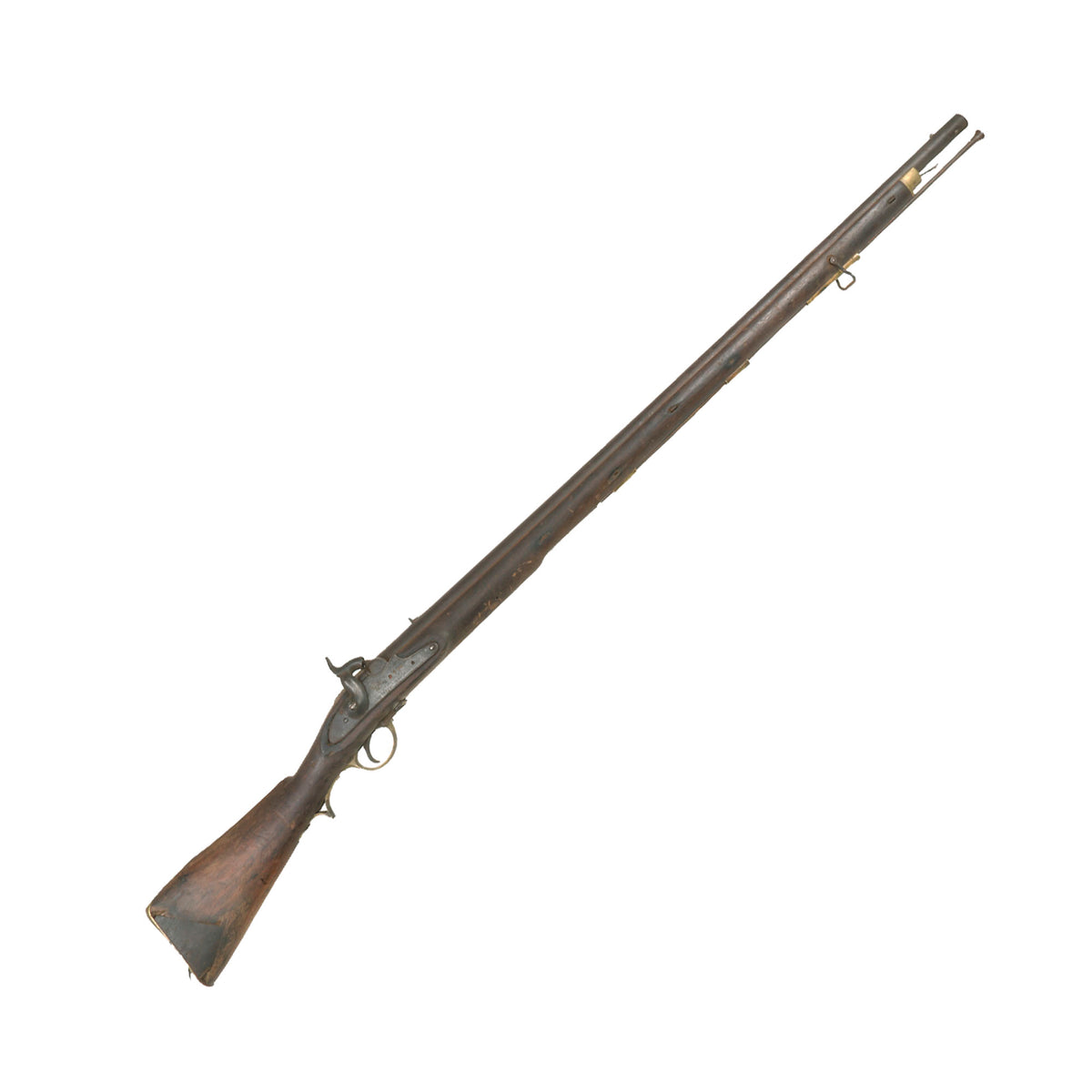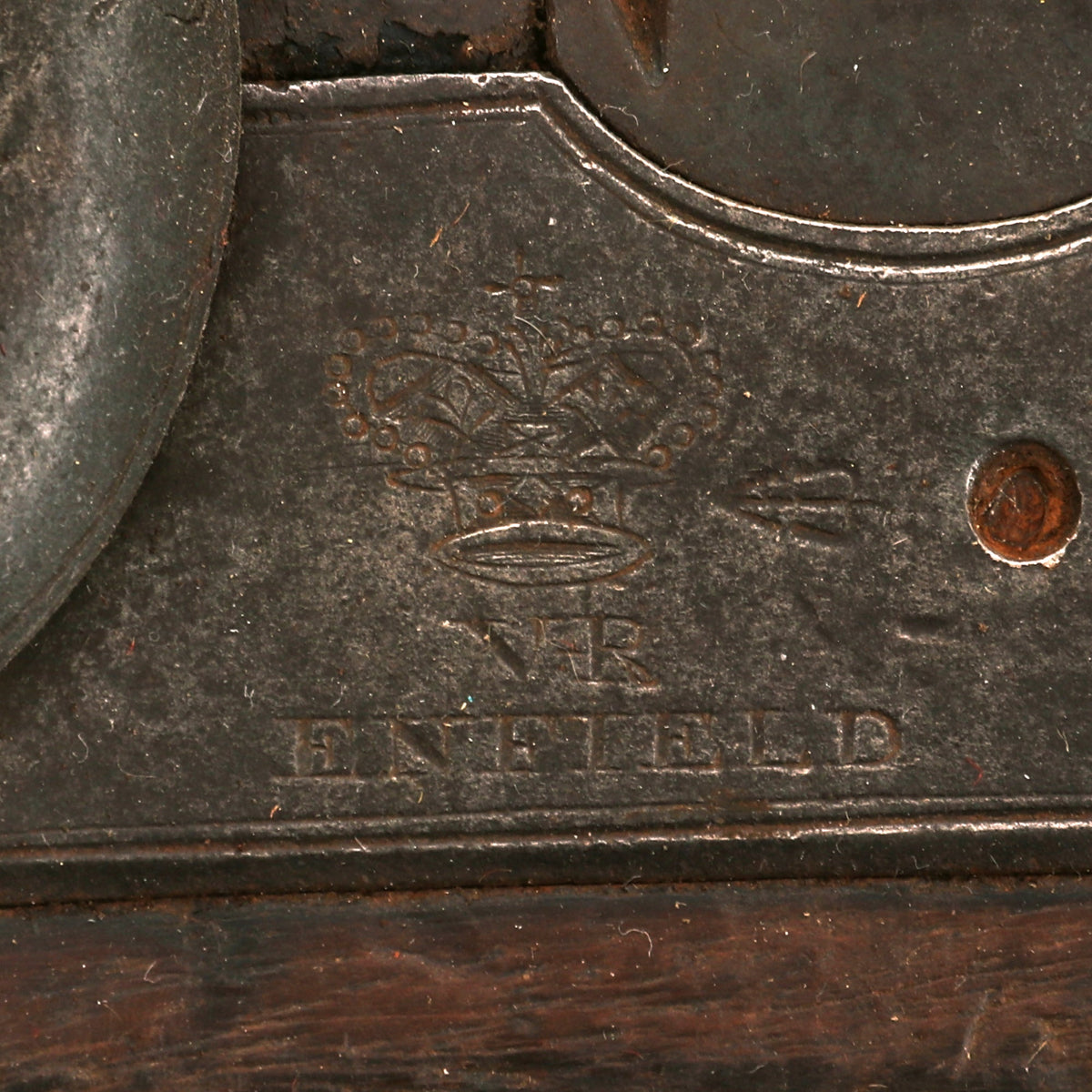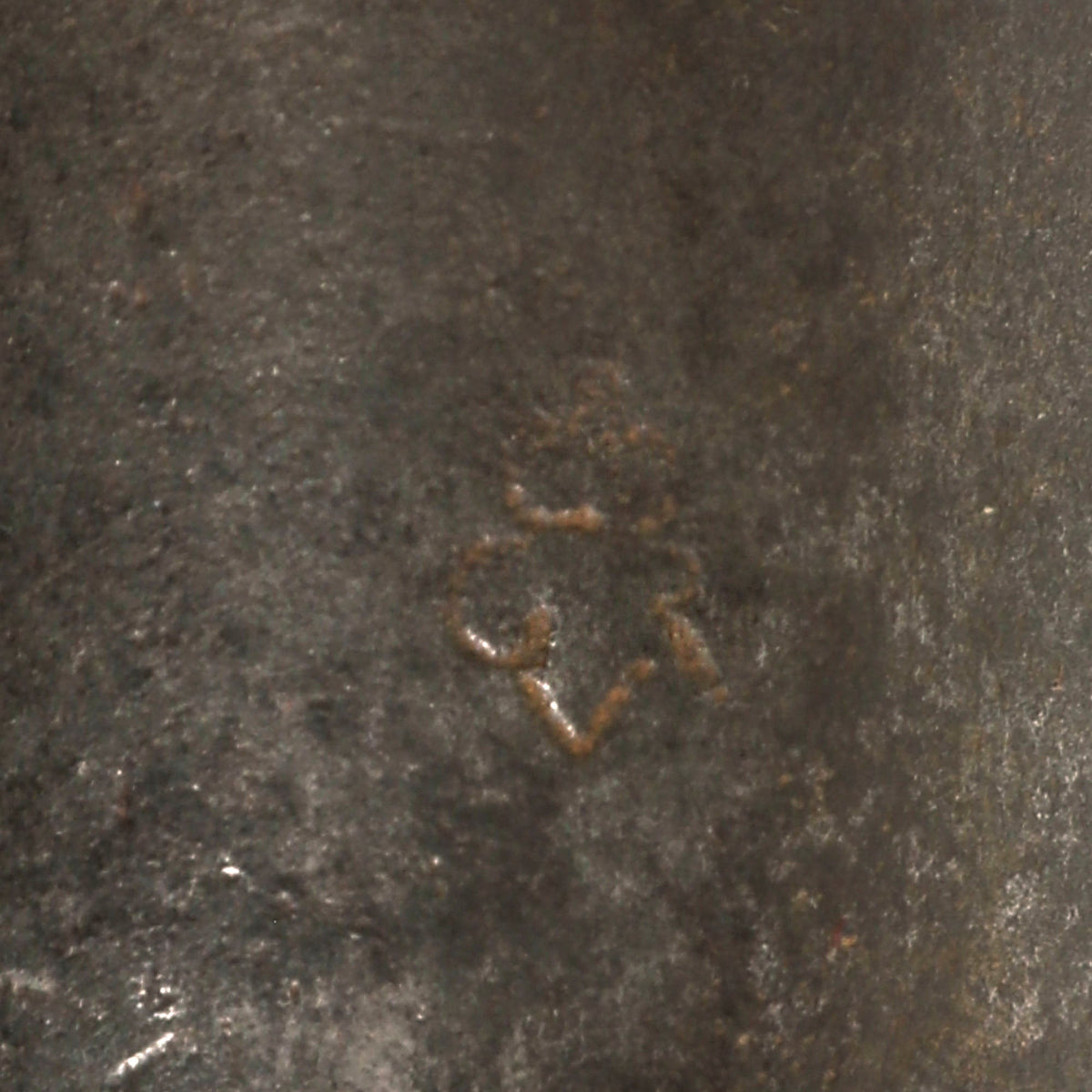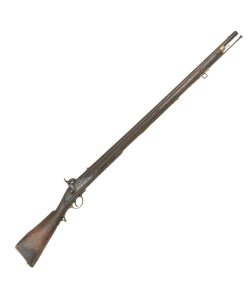Original British East India Company Percussion Musket with British Barrel and V.R. Marked Enfield Lock Dated 1841 Original Items
$ 1.195,00 $ 298,75
Original Item: Only One Available. The Nepalese cache purchase of 2003 is truly the gift that keeps on giving, even after almost 20 years! Many of these have been purchased over the years, and this is a lovely example that was hand picked years ago from our warehouse, and now has made its way back to us. We have had VERY few British made EIC percussion muskets over the years, and this one is definitely a bit of an oddity, with some great research potential!
Approved on April 2, 1845 was the Model F the 6th and final smoothbore Brown Bess style East India Company Musket made in percussion. The flintlock Brown Bess style musket had been obsoleted in the late 1830s and the percussion version introduced. What followed in the 1850s was the rifle musket in the smaller .577 caliber whose paper cartridges were finished in a waxy fat compound that the Sepoy troops interpreted as being derived from cows or pigs either way breaking both Hindu and Muslim religious beliefs. This led to the Indian Mutiny of 1857-1859 that led to the East India Company ceding control of India to the British Government.
This example is one of the very few British made examples we found included in the large number of East India Company weapons we received from the old palace of Lagan Silikhana in Kathmandu, Nepal back in 2003. However it is definitely different than most, and we can’t really call it a “Model F” entirely. It has the Model F style bayonet catch at the front of the nose cap, and also has the barrel held on by wedges that we usually see. The stock is also quite standard for a locally made Model F, and has no ramrod throat, as is correct. It also has a screw in the middle of the brass side plate, a hallmark of EIC muskets. However, both the barrel and lock on this example are British manufacture!
The lock is particularly interesting in that it is marked with the CROWN / V.R. Royal Cypher over ENFIELD, indicating production at the Royal Small Arms Factory at Enfield Lock for the British military, not the EIC. We can only assume that it was pressed into service at some point, and the parts harvested to make an EIC Model F musket. It also has the correct “Lock Viewer” mark to the right of the Royal Cypher. We can tell from the plugged frizzen hole and other holes in the lock plate that this was originally a flintlock, converted to percussion. There is a second “Lock Viewer” mark where the frizzen spring would have been, as well as an 1841 date, which may indicate that was when it was converted to percussion, which would be right in line with modifications that the EIC was doing. The hammer on the lock definitely looks to be of British manufacture as well.
The barrel has a faint CROWN / GR / IV proof, indicating it was produced during the reign of George IV (1820-1830). There are some faint other markings, as well as what looks to possibly be some copper inlay or other designs. We were not able to find any other markings on the musket.
Condition is very good, though it definitely saw long service before it arrived in Nepal. It retains both sling swivels and the ramrod, as well as the rear sight, with a lovely matured patina to the metalwork. We tested the lock, and it holds correctly at half cock, firing at full. The stock definitely does show some damage, and has a large wood graft repair on the right side of the butt stock against the brass butt plate. The musket looks to only have been light cleaned after being pulled from the pile to preserve the history.
This is definitely a rare opportunity to pick up an EIC musket with a very interesting history full of research potential. Ready to display!
Specifications:
Year of Manufacture: circa 1841
Caliber: .75 inches
Ammunition Type: Lead Ball & Powder with Percussion Cap
Barrel Length: 39 inches
Overall Length: 54 1/4 inches
Action: Side Action Percussion Lock
Feed System: Muzzle-Loaded
Official records tell us that the British East India Company procured or made no Flintlock Muskets after the late 1820s and it appears they were very swift to take advantage of the newest in firearms technology- the percussion ignition system. In 1840 the EIC began producing the world’s very first massed produced percussion musket that later became known as the EIC Model “C”.
A brief history of how this model came to being- The shortened 39″ barrel Brown Bess musket was first developed and adopted by the EIC in 1771. This was a full 25 years before the Board of Ordnance in London followed suit with a 39″ Brown Bess Musket dubbed the “India Pattern” in 1796. This is a testament that private enterprise has seemingly always got things done long before government bureaucrats. In 1839 the British Government officially adopted a converted to percussion Brown Bess musket (P-1796/39) but in the Great Fire of the Tower of London of 1841 over 400,000 of these converted Muskets were destroyed leaving the British Government very short handed. The result, once again, was to copy the current EIC Percussion Musket, the Model “F” and designate it the “Lovell’s Pattern of 1842”. By that time, the EIC had already developed and refined the .75 bore Percussion musket through six models- A to F.
Models A and B were EIC flintlock muskets converted to percussion. However, the Model C was the very first purpose built percussion issue, although, it appeared to be a conversion; it was in fact made from all new percussion oriented parts. It was fitted with what was referred to as an “Old Series” side lock that looks like it was once a flintlock. It was also originally intended only to accept the Brown Bess socket bayonet secured on the foresight block. In general the vast majority of these “Old Series” muskets were later adapted with either Hanoverian or the Model F bayonet catches. The differences between the various EIC Models are generally minor; as stated Model A and B were Brown Bess flintlock conversions, Model C and D were purpose built percussion muskets but had the “Old Series” side locks with differing trigger guard styles, while the Model E and F both had the “new series” side locks and had either the Hanoverian Catch on the Model E or the EIC bayonet catch on the Model F.
Please See David Harding’s stellar work Smallarms of the East India Company 1600-1856, published in four volumes by Foresight Books in 1997. Specifically, please see Volume 2, pages 97-124 for a mass of information concerning the vary EIC Model muskets.
NOTE: International orders of antique firearms MUST be shipped using UPS WW Services (courier). USPS Priority Mail international will not accept these. International customers should always consult their country’s antique gun laws prior to ordering.
Fast Shipping with Professional Packaging
Thanks to our longstanding association with UPS FedEx DHL, and other major international carriers, we are able to provide a range of shipping options. Our warehouse staff is expertly trained and will wrap your products according to our exact and precise specifications. Prior to shipping, your goods will be thoroughly examined and securely secured. We ship to thousands clients each day across multiple countries. This shows how we're dedicated to be the largest retailer on the internet. Warehouses and distribution centres can be located throughout Europe as well as the USA.
Note: Orders with more than one item will be assigned a processing date depending on the item.
Before shipping before shipping, we'll conduct a thorough inspection of the items you have ordered. Today, the majority of orders will be delivered within 48 hours. The delivery time will be between 3-7 days.
Returns
The stock is dynamic and we cannot completely manage it because multiple stakeholders are involved, including our factory and warehouse. So the actual stock may alter at any time. It's possible that you may not receive your order once the order has been made.
Our policy is valid for a period of 30 days. If you don't receive the product within 30 days, we are not able to issue a refund or an exchange.
You can only return an item if it is unused and in the same state as the day you received it. You must have the item in its original packaging.
Related products
Uncategorized
Uncategorized
Uncategorized
Uncategorized
Uncategorized
Uncategorized
Uncategorized
Uncategorized
Uncategorized
Uncategorized
Australian WWII Owen MK1 Machine Carbine SMG Custom Fabricated Replica with Sling Original Items
Uncategorized
Uncategorized
Uncategorized
Angolan Rebel 1970s era 60mm Inert Display Mortar from Angolan Civil War Original Items
Uncategorized
Uncategorized
Uncategorized
Uncategorized
Armored Burgonet Helmet & Polearm from Scottish Castle Leith Hall Circa 1700 Original Items













































































